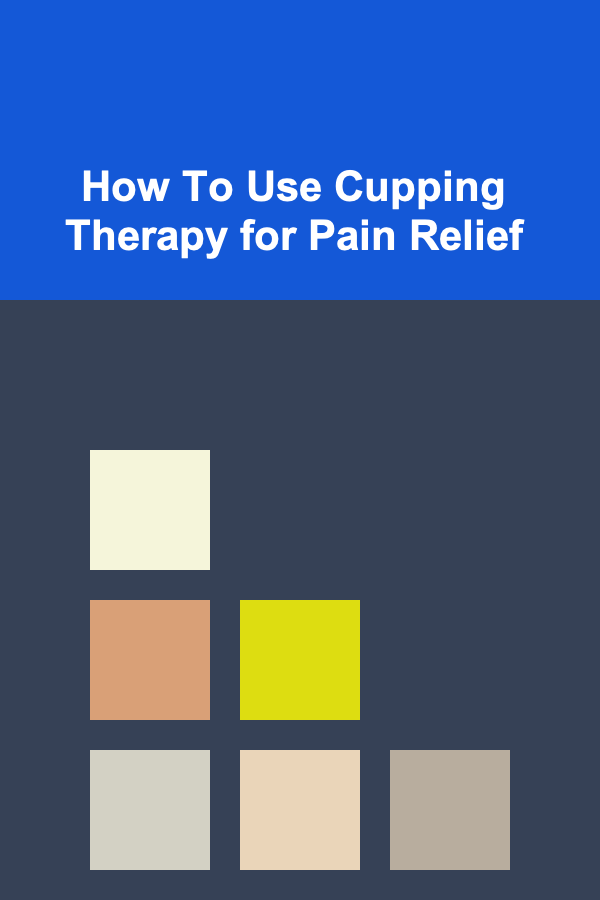
How To Use Cupping Therapy for Pain Relief
ebook include PDF & Audio bundle (Micro Guide)
$12.99$6.99
Limited Time Offer! Order within the next:

Cupping therapy is an ancient alternative medicine practice that has been used for thousands of years in various cultures worldwide. It is known for its therapeutic effects, especially in the relief of pain and muscular tension. This therapy involves placing special cups on the skin to create suction, which is believed to promote blood flow, reduce inflammation, and provide relief from pain. Although it is not as mainstream as other forms of treatment, cupping has gained increasing popularity in recent years, especially among athletes and those seeking natural remedies for chronic pain.
In this article, we will explore the origins and history of cupping therapy, the different types of cupping, how to use cupping therapy for pain relief, the science behind its effectiveness, and some safety considerations. By the end of this article, you should have a comprehensive understanding of cupping therapy and how it can be used as an alternative treatment for pain management.
The Origins and History of Cupping Therapy
Cupping therapy has a long and rich history that spans across different cultures. Its earliest origins can be traced back to ancient Egypt, where it was depicted in the famous Ebers Papyrus, which dates back to around 1550 BC. The practice was also common in ancient China, Greece, and the Middle East.
In Chinese medicine, cupping therapy was first documented in the Huangdi Neijing , an ancient medical text that outlines the fundamental principles of traditional Chinese medicine (TCM). It is believed that cupping was used to remove "wind" and "cold" from the body and to restore balance in the flow of qi (the body's vital energy).
Throughout history, cupping therapy has been practiced by physicians, healers, and alternative medicine practitioners across cultures. For example, the famous Greek physician Hippocrates, known as the "father of medicine," used cupping as a method to treat a variety of ailments.
In modern times, cupping therapy has seen a resurgence in popularity, especially among athletes and individuals seeking natural, non-invasive methods of pain relief and muscle relaxation. Celebrities and high-profile athletes, such as swimmer Michael Phelps, have openly endorsed cupping therapy, helping to increase its visibility and acceptance in Western medicine.
Types of Cupping Therapy
Cupping therapy can be performed using several different techniques, each of which provides its own benefits. The main types of cupping therapy are:
1. Dry Cupping
Dry cupping is the most common and traditional form of cupping therapy. In this method, the practitioner uses cups made from materials such as glass, bamboo, or silicone, and creates a vacuum within the cups by heating them or using a suction pump. The cups are then placed on the skin, typically along the back, shoulders, or other areas of the body that require treatment.
The vacuum effect draws the skin and underlying tissues into the cup, which is believed to increase blood circulation, relieve muscle tension, and promote healing. This process also stimulates the body's natural ability to remove toxins and improve overall wellness.
2. Wet Cupping (Hijama)
Wet cupping, also known as hijama, involves a slightly more invasive technique than dry cupping. In this method, after the cups are placed on the skin and suction is applied, small incisions are made on the surface of the skin. This allows for the controlled removal of a small amount of blood, which is believed to remove stagnant blood, toxins, and other impurities from the body.
Wet cupping is commonly practiced in Islamic cultures and is thought to be beneficial for treating a wide range of ailments, from chronic pain to inflammation and fatigue. However, wet cupping should only be performed by a trained professional, as it involves bloodletting.
3. Moving Cupping (Massage Cupping)
Moving cupping, or massage cupping, is a variation of dry cupping that involves the practitioner moving the cups along the skin while maintaining suction. This technique is often used on areas with significant muscle tension or where there is a need for deeper tissue work.
In moving cupping, the practitioner may use oil or lotion on the skin to facilitate smooth movement of the cups. The motion of the cups can help release tight muscles, improve circulation, and relieve pain in a more dynamic manner than stationary cupping.
4. Fire Cupping
Fire cupping is one of the oldest methods of cupping therapy, and it is still used in traditional practices today. This technique involves creating a vacuum inside the cup by briefly heating the air inside it with fire, usually by lighting a cotton ball soaked in alcohol and placing it inside the cup.
Once the air inside the cup is heated, it creates a vacuum effect as it cools, causing the cup to adhere to the skin. The heated cups are then placed on the body for the purpose of stimulating blood flow, promoting healing, and easing muscle tension.
5. Magnetic Cupping
Magnetic cupping is a modern variation of cupping therapy that incorporates magnets into the cups. These magnets are thought to provide additional therapeutic benefits, such as improving circulation and balancing the body's electromagnetic field.
While scientific evidence on the benefits of magnetic cupping is limited, some proponents believe that the magnetic field enhances the healing properties of cupping by encouraging better blood flow and energy flow within the body.
How Cupping Therapy Works for Pain Relief
Cupping therapy is believed to work through several mechanisms that contribute to pain relief and muscle relaxation. Although the exact science behind cupping is still debated, several theories have been proposed to explain how it may be effective for pain management.
1. Increased Blood Flow and Circulation
The suction created by the cups draws blood to the surface of the skin, which increases circulation in the affected area. This improved blood flow is thought to promote the delivery of oxygen and nutrients to tissues, aiding in the healing of injured or inflamed muscles. The increased circulation also helps to flush out toxins and metabolic waste products that can accumulate in the body, contributing to pain and discomfort.
2. Release of Muscle Tension
Cupping therapy is particularly effective at releasing muscle tension. The suction effect can help to loosen tight muscles, increase flexibility, and relieve stiffness. By creating a negative pressure around the muscles and fascia (the connective tissue surrounding muscles), cupping may help break up adhesions and fascial restrictions that contribute to chronic pain and limited mobility.
3. Activation of the Body's Natural Healing Processes
Cupping therapy is thought to stimulate the body's parasympathetic nervous system, which is responsible for promoting relaxation and healing. By encouraging blood flow, reducing muscle tension, and stimulating nerve endings, cupping may help activate the body's natural healing processes. This can result in pain reduction, faster recovery from injuries, and an overall sense of well-being.
4. Reduction of Inflammation
Inflammation is a common cause of pain, especially in conditions like arthritis and chronic back pain. Cupping therapy may help to reduce inflammation by improving blood circulation, promoting lymphatic drainage, and stimulating the immune system. By addressing the underlying inflammation, cupping may provide relief from pain caused by both acute and chronic conditions.
5. Endorphin Release
Cupping therapy may also stimulate the release of endorphins, the body's natural painkillers. Endorphins help to reduce pain and induce a sense of relaxation and well-being. The release of these chemicals can contribute to both short-term pain relief and long-term improvements in overall health.
How to Use Cupping Therapy for Pain Relief
To use cupping therapy for pain relief, it is important to follow a few basic steps. While cupping can be performed at home using a cupping set, it is always best to consult a trained professional before attempting it on your own. A licensed acupuncturist or a practitioner with experience in cupping therapy will have the necessary knowledge to ensure that the therapy is done safely and effectively.
Here is a general guide to using cupping therapy for pain relief:
Step 1: Identify the Area of Pain
Before beginning cupping therapy, identify the area of pain or tension. This could be a muscle group, such as the lower back, shoulders, or neck, or an area of chronic pain, such as joint pain caused by arthritis. Cupping is most effective when it is targeted at specific areas where pain or muscle tightness is present.
Step 2: Choose the Type of Cupping
Decide on the type of cupping therapy that best suits your needs. For most individuals, dry cupping is an effective option for relieving muscle pain and tension. Wet cupping may be used for chronic conditions or for removing stagnation, but it should only be performed by a trained professional.
Step 3: Set Up the Cupping Equipment
If you are performing cupping therapy at home, make sure you have the proper equipment. A cupping set typically includes several cups, a pump for creating suction, and sometimes a heating device for fire cupping. Ensure that all cups and tools are sanitized before use to avoid any risk of infection.
Step 4: Prepare the Skin
Before placing the cups on the skin, clean the treatment area with soap and water to remove any oils or dirt. In some cases, applying oil or lotion can help facilitate smoother movement of the cups if you are performing moving cupping.
Step 5: Apply the Cups
Using the cupping device, apply the cups to the treatment area. The cups should create a firm seal around the skin. You may feel a slight pulling sensation as the suction is applied, but it should not be painful. If you experience discomfort, reduce the suction or remove the cups immediately.
Step 6: Leave the Cups in Place
For stationary cupping, leave the cups in place for around 5 to 15 minutes, depending on your tolerance and the severity of the pain. The cups should create visible marks on the skin, which is normal. These marks are temporary and will fade within a few days.
Step 7: Remove the Cups and Follow Up
Once the treatment time is complete, remove the cups by gently releasing the suction. After cupping, you may feel relaxed or have a mild soreness in the treated area, but this should subside within a few hours. Drinking plenty of water after cupping therapy is essential to help flush out toxins and rehydrate the body.
Safety Considerations and Risks
While cupping therapy is generally considered safe when performed by a trained professional, there are some risks and safety considerations to keep in mind:
- Skin Sensitivity: Some people may experience skin irritation or bruising after cupping therapy. This is usually temporary and fades within a few days.
- Underlying Health Conditions: If you have certain health conditions, such as skin disorders, heart disease, or blood clotting disorders, you should consult a healthcare provider before attempting cupping therapy.
- Proper Technique: It is important to ensure that the cupping technique is performed correctly to avoid injury or burns (in the case of fire cupping). Always seek guidance from a trained practitioner.
- Hygiene: Ensure that the cups and equipment are clean to prevent the risk of infection, particularly if performing wet cupping.
Conclusion
Cupping therapy offers a natural and effective alternative for pain relief, particularly for muscle tension, inflammation, and chronic pain conditions. By improving blood circulation, releasing muscle tension, and stimulating the body's natural healing processes, cupping can provide significant benefits for those seeking a non-invasive treatment for pain.
While cupping therapy may not be suitable for everyone, it has been proven to be an effective treatment for many individuals seeking pain relief. As with any alternative therapy, it is important to consult a trained professional before attempting cupping, particularly if you have underlying health conditions or concerns.
Reading More From Our Other Websites
- [Home Space Saving 101] How to Master Maximizing Closet Space with Smart Organization Hacks
- [Personal Investment 101] How to Use Deep Learning to Build Scalable Passive Income Models
- [Organization Tip 101] How to Create a Kid-Friendly Snack Zone in the Kitchen
- [Beachcombing Tip 101] Essential Gear for Successful Beachcombing: A Comprehensive Buying Guide
- [Home Soundproofing 101] How to Use Acoustic Caulk and Sealant for a Quieter Home Environment
- [Home Pet Care 101] Understanding the Different Types of Cat Litter
- [Home Staging 101] How to Stage a Home for Millennial Buyers
- [Home Party Planning 101] How to Set Up a DIY Dessert Bar for Your Home Party
- [Home Maintenance 101] How to Protect Your Home's Flooring from Wear and Tear
- [Home Security 101] How to Use Home Security Apps to Keep Your Property Safe

How to Organize a DIY Family Art Project Day
Read More
The Art of Construction Estimation: Best Practices for Precise Cost Calculations
Read More
Top 10 Affordable Children's Party Ideas That Will Wow the Kids
Read More
Promoting Sustainable Tourism: A Deep Dive
Read More
How To Optimize Your Small Business Website for SEO
Read More
How to Communicate Insights Effectively as a Business Intelligence Analyst
Read MoreOther Products

How to Organize a DIY Family Art Project Day
Read More
The Art of Construction Estimation: Best Practices for Precise Cost Calculations
Read More
Top 10 Affordable Children's Party Ideas That Will Wow the Kids
Read More
Promoting Sustainable Tourism: A Deep Dive
Read More
How To Optimize Your Small Business Website for SEO
Read More